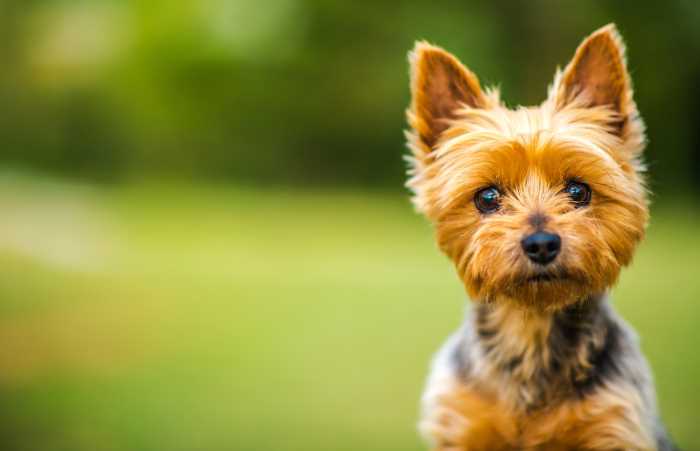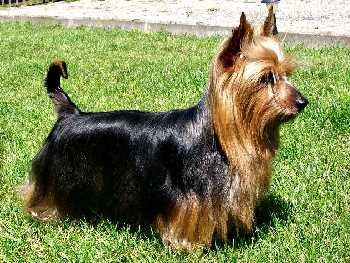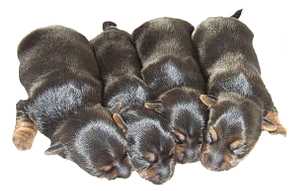Australian Silky Terrier
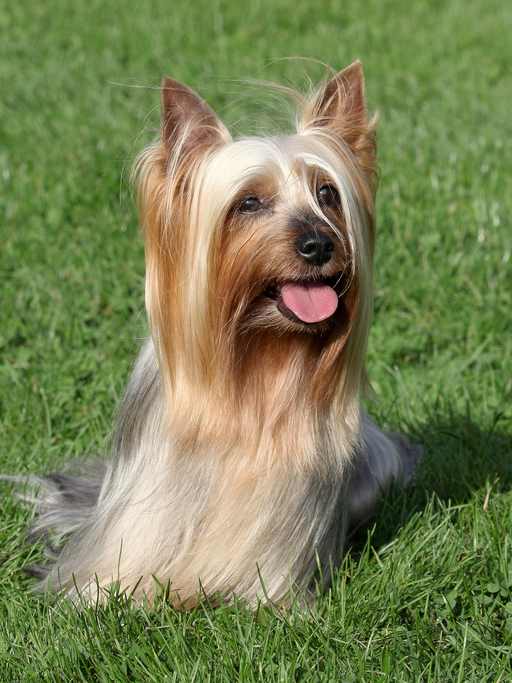 Australian Silky Terrier Dog Breed
Australian Silky Terrier Dog BreedBy Janice Jones Last Updated 02-28-2020
The Silky Terrier is bold, confident and inquisitive, a dog that is always ready for action.
Here is a dog that is terrier through and through with all those endearing traits: smart, yet stubborn and mischievous, yet loyal.
Even though they are members of the AKC toy group, they are not your average lap dog even though they make excellent companions and great family dogs.
Their loyalty to their owners coupled with their small size and low-shedding coat makes them an ideal choice for those in apartments or urban settings.
They are alert and ready to bark at any change to their environment. This makes them an excellent watchdog.
Always ready for a walk or a romp in the yard, these dogs make ideal choices for active singles, couples, or families with older children.
The breed is called the Silky Terrier in North America but is called the Australian Silky Terrier in its country of origin and the rest of the world.
They do well in a wide variety of dog sports including obedience, agility, rally, herding, flyball, tracking and earthdog trials.
The Silky Terrier Dog Breed at a Glance
| Traits | Rating |
|---|---|
| Playfulness | |
| Affection Level | |
| Friendliness Towards Strangers | |
| Good with Children | |
| Good with Other Dogs | |
| Good for First Time Owners | |
| Exercise Needed | |
| Ease of Training | |
| Watch Dog Ability | |
| Grooming Requirements | |
| Shedding | |
| Cold Tolerant | |
| Heat Tolerant |
Explanations for At a Glance Ratings
- Playfulness: Most=5 Less=1
- Affection: Most=5 Least=1
- Friendliness Towards Strangers: Most=5 Least=1
- Good with Children: Good=5 Not Good=1
- Good with Other Dogs: Good=5 Not Good=1
- Good for First Time Owners: Good=5 Not Good=1
- Amount of Exercise Required: Much=5 Minimal=1
- Ease of Training: Easy=5 Difficult=1
- Watch Dog Ability: Excellent=5 Poor=1
- Grooming Needs: Extensive=5 Minimal=1
- Shedding: Heavy Shedding=5 Minimal Shedding=1
- Cold Tolerance: Cold Well Tolerated=5 Poorly Tolerated=1
- Heat Tolerance: Heat Well Tolerated=5 Poorly Tolerated=1
Quick Facts about the Silky Terrier
Other Names Used: Australian Silky Terrier, Silkys
Affiliation: AKC, KC, NZKC, ANKC, CKC: Toy, UKC: Terrier
Size
Height: 9-10 Inches (23-26 cm)
Weight: 8-10 Pounds
Coat Type: Single Coat, Soft, and Silky
Colors: Blue and Tan
Country of Origin: Australia
Activity Level: Active
Life Expectancy: 12-15 Years
Good with Children: Yes, Especially older children
Good with other pets: Yes, May chase pocket type Pets: May be aggressive towards larger dogs
History
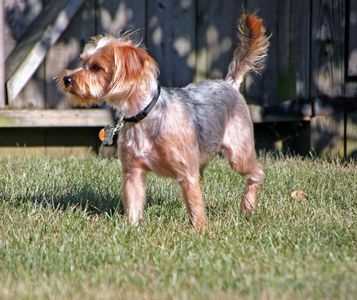 Silky Terrier Clipped
Silky Terrier ClippedAs a relatively newer breed, the Silky Terrier can trace their beginnings to Australia in the late nineteenth century.
Yorkshire Terriers were brought to mate with the Australian Terrier although even the Yorkshire and Australian Terriers were recent developments from crosses of other terrier breeds.
Some of the offspring were considered a separate breed, being an intermediary in size and coat length between from the parents.
A new strain of dog was produced within a short time when this group of offspring mated. There were two areas in Australia (Sydney and Victoria) responsible for creating these new dogs with each area drawing up their standards.
The breed was primarily
developed to be a companion but still retains skills for killing
vermin. By 1926, a compromise was made, and one standard was accepted.
Initially,
the breed was known as the Sydney Silky Terrier then the name was
changed to the Australian Silky Terrier in 1955. They were later
recognized by the Australian National Kennel Council in 1958 and given
the designation of Toy Breed.
The breed made its way to America via servicemen stationed in Australia during and after World War II. The U.S. adopted the name, Silky Terrier and the AKC recognized the breed in 1959 and placed in the Toy Group.
Although very popular when first introduced, the Silky Terrier is ranked 98th today by the American Kennel Club.
Personality
Many believe that the Silky Terrier is the result of the best between the Australian Terrier and the Yorkshire Terrier but still distinct.
He is likely to be the center of attention, friendly to strangers, and hoping to win you over with all his charms.
He is smart
and sassy and has a way of training his owners to do everything he would
like. For this reason, a strong but gentle approach is needed to
offset his rather demanding nature.
These dogs are not for those
who hate barking because the Silky can be very vocal at times. Don’t
fall for the looks—he is still a terrier, through and through, ready to
dig and chase and play.
Still small at 10 pounds, these dogs can be highly portable and would be good for someone who intends to travel with their dog. Most will fit comfortably under an airline seat or in a car seat for a road trip.
Since they are a bit bigger than the Yorkshire
Terrier, they make a better choice for families with active children.
No dog, however, should be subjected to rough, unsupervised play by
children.
Training is something that should begin immediately. They
need to be socialized around a wide variety of people and to her animals
and because they are smart, should do well with a firm but gentle
approach.
Like many of the small breed dogs, housebreaking can be a
problem and make take longer than it would to potty train a large breed
dog. Setting up a schedule and sticking to it is important.
Consistency is always the key to successful housebreaking.
Their long
coat is silky soft but does require a deal of work to keep mats from
forming. The ideal owner will also enjoy brushing and all the other
tasks that go along with owning a long haired breed.
Alice J. Kane, author of Silky Terrier: Comprehensive Guide to Owning and caring for your dog, sums up their personality succinctly...
“Many owners
call their Silky's the just right dog—just the right size, just the right
temperament, just the right companion.”
Grooming
Standards vary from country to country. In the U.S. Tail docking is still part of the AKC standard. In other parts of the world, the tail is not docked as is shown in the picture to the left.
A Silky’s coat is long but not flowing to the ground. It is
silky soft and consists of a single layer that needs to be brushed and
combed several times a week. A small amount of spray on conditioner
prior to brushing will help loosen any mats that form and make the
process much easier.
A pin brush or soft slicker brush works well
for a Silky’s hair. A bristle brush will also work well. A metal comb
is needed to finish and assure that all the mats have been removed.
They need a bath about every three weeks or more frequently if they tend
to get dirty. Use a good quality shampoo followed by a conditioning
rinse.
Silkys are groomed similar to Yorkshire Terriers, and you can
do it yourself at home or take your dog to a groomer. Even if you plan
to keep your dog’s hair long, there are parts of his body that will need
trimming. A sanitary clip cleans up all the private parts and assures
he will stay more decent.
Hair continues to grow around the feet,
so it is important to trim the hair between the paw pads and around the
feet. They are less likely to bring in mud and dirt on their feet if
the hair has been clipped short.
The back and front of the ear tips
are trimmed to about 2/3 down from the top. The insides of the ears can
be clipped down to the head.
Other than that, most of the grooming tasks are typical of other breeds. Check their ears and eyes for debris and clean if necessary. Clip their nails about every 2 to 3 weeks and brush their teeth daily if possible at least several times a week.
Health Concerns
The Silky Terrier is a healthy breed, with a lifespan estimated at 12 to 15 years. Just like people, all small dogs have the potential to develop genetic problems, some of which can be reduced through genetic testing of the parent dogs.
Many of the problems
associated with Silky Terriers are also common in other breeds so don’t
let this list scare you away from this breed.
Patellar Luxation This condition occurs when the groove of the femur is too shallow, the
patella or kneecap will slip out when the leg is bent
Progressive Retinal Atrophy (PRA)
An
inherited disease of the retina which can affect both eyes. It begins
with night blindness and gradually progresses to full blindness as the
retina deteriorates. .
Legg-Calvé-Perthes Disease
A condition in
which the head of the femur (large leg bone) begins to die as a result
of an interruption of the blood supply. This results in pain and
lameness
Corneal ulceration
This is a problem in any breed where the eyes tend to be prominent. Ulcers can become an infection.
Color Dilution Alopecia
Dogs
with this condition are born with a healthy hair coat but may start to
show signs by six months to 3 years of age. Usually starting as a
bacterial skin infection on the back and then progressing to hair loss.
It is often seen in dogs bred for the fawn color.
Tracheal Collapse
This
usually occurs in older dogs because the c-rings that make up the
trachea are not rigid enough to hold the trachea in place, so the
trachea collapses when the dog inhales.
Pros
- Loyal, playful companions
- Right size for apartment living and travel
- Relatively healthy breed
- Great for those who enjoy walks
- Gets along well with children
Cons
- Requires more grooming than short-haired dogs
- Can be a vocal breed
- Needs patient, consistent but gentle training methods
- Terrier characteristics mean they will have a high prey drive
- Likes to dig
- Housebreaking might be challenging
Breed Club
Rescue Information
For information about adoption and rescue, a good place to start is Petfinders, a searchable database of adoptable animals.
You
can also search their nearly 14,000 animal shelters and adoptions
organizations in the U.S., Canada, and Mexico.
We always recommend that you know as much about the breed of your choice before you begin your search for an adoption agency or a reputable breeder. The following may be useful and can be purchased from Amazon.
About Janice (author and voice behind this site)
Having lived with dogs and cats most of her life, Janice served as a veterinary technician for ten years in Maryland and twelve years as a Shih Tzu dog breeder in Ohio.
Her education includes undergraduate degrees in Psychology with a minor in biology, Early Childhood Education, and Nursing, and a master's in Mental Health Counseling.
She is a lifelong learner, a dog lover, and passionate about the welfare of animals. Her favorite breed for over 50 years has been the Shih Tzu, but she has also lived with Poodles, Maltese, Yorkshire Terriers, Beagles, English Bulldogs, Carin Terriers, and a Cocker Spaniel.
When not writing, reading, and researching dog-related topics, she likes to spend time with her eight Shih Tzu dogs, husband, and family, as well as knitting and crocheting. She is also the voice behind Miracle Shih Tzu and Smart-Knit-Crocheting
Does This Article Deserve Your Thumbs Up?
We always appreciate your support and encouragement. Your thumbs up means so much to us. Please like this article.
If you find this page or any page on Small Dog Place Helpful, or useful in anyway, I'd love it if you would click the small heart found on the bottom right of each page.
You can also share or bookmark this page -- just click on the:

Free Monthly Newsletter
Sign Up for Our Free Newsletter and get our Free Gift to You.
my E-book, The Top 10 Mistakes People Make When Choosing a Dog (and how to avoid them)
